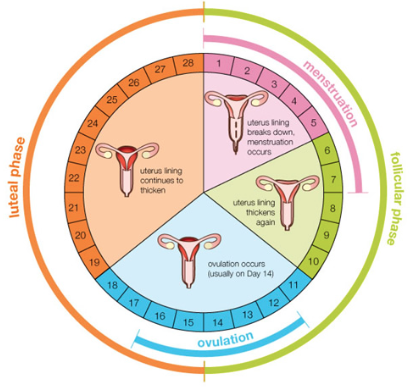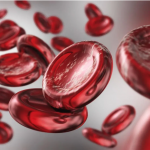Are you wondering when your next ovulation cycle is? Are you using an app to keep track of it?

Not every woman is aware of their ovulation cycle.[1] The ovulation cycle is one of the most important parts of the menstrual cycle and it is necessary to be familiar with it. Whether you want to get pregnant, avoid pregnancy, or just be aware of your menstrual health, tracking the ovulation cycle is important.
Ovulation usually occurs around the 14-15th day of the menstrual cycle. Since you cannot keep track of it, people prefer having a track using the ovulation calculator.
The ovulation calculator helps you determine the best time when you are fertile. The calculator is further important for helping you get pregnant. Apart from that, the calculator also enables you to determine the average length of your ovulation cycle.
What is the best time to conceive?
Experts suggest that ovulation is the best time to conceive. It is during this time that women’s fertility is at its peak. To ensure you can conceive, you need to ensure that the partner’s sperm and fertile eggs get together.[2] During the ovulation, the egg is released and is the best time to get fertile. However, if the eggs do not get fertilized after the release, they degenerate and are released as menstruation blood.
Sex and Conception
Having an ovulation calculator will give you an idea about your fertility window. Since you are now aware of the ovulation cycle, you can ensure that you have sex throughout the cycle. This increases your chances of conception.[3] Good quality sperm is vital to get the eggs fertilized after the release of an egg. While your ovulation cycle is necessary, the couples must have an active sex life too.
Having sex a few days before the ovulation cycle and then continuing it up to the days of the cycle can eventually increase your chances of conception. Your fertility window is at its peak during the ovulation, and so the chances of conception are high too. If you have missed your period, make sure to take a test at home for a better idea.[4]
How to spot the signs of ovulation?
Ovulation occurs sometime around 10-16 days before the next menstruation cycle. Thus, you may prefer getting a general idea about the ovulation cycle.
People having contraceptive pills usually have a tough time conceiving because their ovulation cycle does not occur normally. You may prefer marking your ovulation dates on the calendar starting from the day you bleed. If you want to know about your ovulation cycle, keep a check on how your many days your previous period lasted. Depending on the days of your period lasting, you will be able to figure out the length of your menstrual cycle.
- Changes in the cervical mucus
In the initial phases of the menstrual cycle, the cervix secretes mucus, which is white, thin, and clear. With the ovulation cycle coming closer, the mucus turns thin and slippery. Women also experience a stretchy nature appearing as a raw white eff.[5]
The thinner the mucus, the easier it will be for the sperm to swim across it. This is most prevalent during the fertile period. Thus, if you want to conceive, this may be the best time to have sex. However, you need to avoid it and use contraception to have safe sex to avoid pregnancy.
Women experience watery secretions in the final phases of ovulation, and this is referred to as the peak day.
- Temperature
The temperature changes are also great indicators of menstrual cycle changes. You need to keep a record of your temperature every morning. An increase in temperature is a clear sign of the beginning of the ovulation cycle. However, this is only an indication of when the ovulation cycle starts and does not tell you when your fertile window opens.
Should you be using ovulation test kits?
Most women use the ovulation test kits, also popularly referred to as ovulation predictor kits. These are easily available at the chemist’s and are very easy to use. The ovulation test kits check for hormones in urine to find when the ovulation would occur.
The ovulation test kits often check for a luteinizing hormone that increases mostly 24-36 hours before ovulation. This indicates the perfect time for conception. However, the fertility window may vary from person to person.[6]
Health professionals suggest being aware of the general fertility window to ensure the best. The regular menstrual cycle can be of great help to determine when you should test.[7] The ovulation predictor kit, apart from helping you find the perfect time for ovulation, also helps to check for the fertility window. However, you may keep more than one test kit with you to be sure.

Ovulation calculator
Several online websites have launched the ovulation calculator for women eager to know about their ovulation cycle. Most of these websites have also launched the calculators so you can keep an easy track of your cycle.
Benefits of ovulation calculation
Ovulation calculation can prove to be beneficial in a lot of aspects.[8] It is always suggested that you calculate the ovulation cycle if
- You want to get pregnant
- You want to avoid pregnancy
- You are noticing signs and symptoms of ovulation such as abdominal bloating, increased sex drive, breast tenderness, cramping, and swollen nipples.
Missing out on periods (if you are not pregnant) is a sign of any underlying condition. You need to ensure that you keep a check with your ovulation cycle to keep the health risks at bay.[9] If you haven’t been ovulating properly, you will need to see a doctor as soon as possible, as it can be a hindrance to your pregnancy.
[1] https://www.ncbi.nlm.nih.gov/pmc/articles/PMC27529/
[2] Austad SN. Why women live longer than men: sex differences in longevity. Gend Med. 2006;3(2):79–92. [PubMed] [Google Scholar]
[3] https://www.ncbi.nlm.nih.gov/pubmed/29749274
[4] https://www.ncbi.nlm.nih.gov/pubmed/3402086
[5] Matijevic R, Grgic O. Predictive values of ultrasound monitoring of the menstrual cycle. Curr Opin Obstet Gynecol. 2005;17(4):405–410. [PubMed] [Google Scholar]
[6] Billings E.L., Brown J.B., Billings J.J., and Burger H.G.. 1972. Symptoms and hormonal changes accompanying ovulation. Lancet 1: 282–84. [PubMed] [Google Scholar]
[7] Djerassi C. 1990. Fertility awareness: Jet-age rhythm method? Science 248: 1061–62. [PubMed] [Google Scholar]
[8] https://www.ncbi.nlm.nih.gov/pmc/articles/PMC5689497/
[9] Bauman JE. Basal body temperature: unreliable method of ovulation detection. Fertil Steril. 1981;36(6):729–733. [PubMed] [Google Scholar

